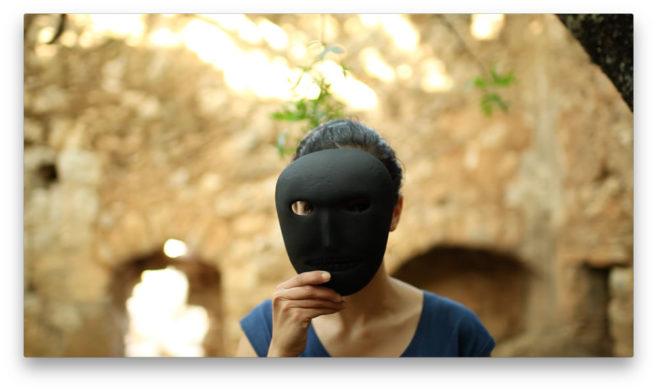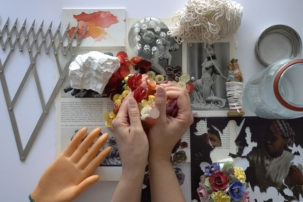Nadia Gohar was the first Egyptian artist I ever met. This is significant for me at least because my first encounters as a 14 year-old in suburban southwestern Ontario were with white people who skirted learning my name in favour of calling me “Cleo,” while the Egyptians at the Coptic church I went to thought I was weird for being “artsy.” At most it’s significant because we don’t have to explain anything to each other.
In mid-April I told her I was returning to Egypt for the first time since 2006, to see the grandmother who raised me the first five years of my life, with my dad. Before the trip, she talked me through my apprehension about returning to Egypt for the first time in 12 years, and when I returned here, to Toronto, we talked about our shared longing to return to Egypt, exacerbated by our current inability to just that. Gohar’s practice has helped her cope by reprocessing food, object and ritual memories in her sculpture and installation. “I’m trying to reconjure everything that was lost or misplaced in my family’s move here,” she says. She chews libb—salted dried watermelon seeds you crack open with your teeth, a social snack common in Egypt regardless of class, with the seed shells piling up as a marker of the passage of time—makes coffee or wraps grape leaves the way her grandmother does, and these acts from her daily life have seeped into her work. “When I come back here I can still do those things, still experience those things. So these acts refresh my memory, but it’s not like they don’t exist without going back. You need that daily refresher.”
In her contribution to The Table, a home-based project space hinging on a feast prepared by the artist, Gohar cooked an Egyptian meal with video fragments of her grandmother—assembling grape leaves, reading the Quran, scrolling her phone—overlooking participants eating grape leaves that Gohar herself had prepared. In her recent exhibition “Foundation Deposits,” curated by Minh Nguyen at SOIL Gallery, she assembled elements of two distinctly Egyptian urban landscapes: a central fountain drawing from Islamic gardens; and red brick walls drawing from the ashwa’iyat, makeshift settlements constructed and populated by low-income Egyptians. She interspersed the structures with time-capsule objects she made with concrete, clay and plaster.
Every day of the six I was in Egypt, my breakfast included basterma: paper-thin slices of cured beef infused with garlic and fenugreek before it’s air-dried. I’m told this is the top import confiscated from Egyptians at Canadian customs. Gohar and I had this conversation over the course of two studio visits, one immediately following my return, and another about a week later. At the first visit my body reeked of basterma. By the second studio visit, the odour had faded. Aside from a four-hour conversation with my mother—about what we ate, what we talked about while we ate, where we went, what I wore there—I have only spoken with Nadia about the trip. Here, she shares with me how she copes.
Merray Gerges: How do you memorize or memorialize the day-to-day things, the mundanities of being there?
Nadia Gohar: I almost want those mundanities to feel mundane again. When you place so much importance on them, they’re not as mundane anymore. It’s a great feeling when you’ve gone back enough times that you’re bored, when you reach a point where you’re just wasting time, slowing down. That’s when it feels normal to be back because that’s what it was like when I was in high school there, going to see my grandma, sitting around the house a lot. The mundane is important but it’s important to keep it mundane. Your trip was on blast; you were trying to eat all the food, see all the people and go to all the places in six days and that can be such a great rush. I love to do that. And then I also love to slow down and have nothing to do. Because that’s the difference between living somewhere and visiting.
MG: The only way to get over this craving for the mundane is to return.
NG: And to live. I always think: How much time has to pass until you can say you live somewhere?
MG: Do these gestures of bringing elements of living there to here make it easier to be here?
NG: Totally, and a lot of the stuff is domestic, like bringing food, bringing artifacts I find around the house. It changes a lot. The more I use sculpture the easier it is to recreate those things. All I want to do is to recreate those domestic objects, and not even change anything about them.
MG: How does food figure into it? Not just eating, but moving through the process of cooking?
NG: When I go back that’s one of the primary things that I pay attention to. When I’m around my grandma, I record her making stuff. Food is inevitable—you can’t go back and not have food be so in your face. I’m sure your family was just, like, shoving it down your throat. In the last two years I really started to think more about how to process any of that. I wasn’t doing that before. I wasn’t taking note. I wasn’t remembering. I wasn’t recording.
MG: What shifted to compel you to begin to record and to take note?
NG: It was a natural progression. When I work now, I’m always referencing photos that I took there. I was painting and drawing a lot but when I stepped away from it I began to make sculptures. I felt like, Why did I show those paintings and drawings in the first place? That was really personal; that work was for me. I feel like I should have just shut up and not put them out there until I felt like I came out with some sort of final product.
MG: That’s very dangerous.
NG: To shut up?
MG: Yeah.
NG: I know. That’s why I’ve been appreciating these really scattered, cluttered shows that I’ve been seeing, because it feels more like a train of thought. It’s not just like, here’s this fully formed thing that I made. It’s more like, here’s a million photos of my mom that I’ve been working on for 10 years. [In this exhibition,] I’m trying to be like: Here’s everything I’ve been doing and here’s this pile of libb I’ve chewed through.
MG: It makes sense in the constellation of what you’re thinking about. You also told me about mimicking these ornamental plaster fixtures. You see tons of them sold on the side of the highway in makeshift stalls. And you see them slapped on to domestic surfaces with no rhyme or reason. When I first saw them in your studio they immediately conjured up for me what I saw when I was driving through Egypt.
NG: I think seeing them in piles is what’s going to get the point across. I’m casting them in plaster. I was like, How do I make this thing? I could buy the mould at the plaster store for like a million dollars, then I was in a kitchen supply store and saw the tops of cake container lids. I’m just gonna go to Seattle with a bunch of cake tops. My suitcase is gonna be filled with some crazy shit.
MG: Have fun at customs.
NG: No, I’m Canadian now. I don’t have to worry about anything anymore.
MG: You can kind of do whatever you want. What about these vases you’re making?
NG: The title of the show is “Foundation Deposits” and it draws from a recent experience I had at the Met, when I was in the Egyptian wing and the two security guards there happened to be Egyptian. They weren’t talking about the work or anything; the woman was just passing through the space and she said something to the guy in Arabic. I was like, Oh my God, did they put them here on purpose? It was such a great moment for me. I was like, Wow, thank you so much for being in this space in the middle of the fucking Met where these objects definitely don’t belong.
I was reading one of the plaques describing domestic objects that were scattered and organized, about these ceremonies that [the Ancient Egyptians] put on any time they erected any sort of major monument or religious temple before the structure went up. They would strategically bury sacred objects—time capsules that were never meant to be unearthed—in important points in the ground under the structure to protect it.
With the vessels I’m making, I’m repeating this ceremonial thing, but above ground. I feel like the key is seeing everything in quantities, then scattering the objects throughout the space so you have to move around them or through them.
MG: The terracotta grapes weren’t here last time I came.
NG: I’m still unsure of them. I’m trying to cut and paste between the natural and the unnatural. I wanted to use concrete in a way that masks itself as terracotta. My dad always talks about how concrete ruined Egypt. So dramatic. He hates new building; he’s always criticizing the concrete slabs and structures you see everywhere in Egypt. He thinks that everything was beautiful before concrete was introduced to us, when people built shit out of simple materials and simple forms, then concrete was this disgusting thing that came at us from the Gulf and changed us forever. So making concrete look like terracotta is just a funny little secret thing for myself where I’m like, oh you think these are terracotta? They’re actually the worst material of all time: concrete.
MG: You’re carving out space for mundanities and for repetition. I wonder how the depository of you chewing libb in your installation will register to Egyptians seeing the show.
NG: Like my dad?
MG: Yeah, what would he have to say about it?
NG: He’s maybe a little more open-minded? I once rested a rug-beater I bought from Egypt on a painting and when my dad saw it he thought it was so funny that I would use this domestic object in an exhibition.
MG: When I was with my dad in Egypt I would notice things that to him are totally banal and not worth cherishing. My aunt was amused by what amused me. I wonder what our parents make of this process that we’re going through right now, our longing for a place that they chose to leave.
NG: Your parents made the decision for you and your family to leave, but I was a bit older and I made that decision for myself.
MG: And your dad has forbidden you from going back—
NG: He’s against it.
MG: Your work is driven by your desire to return but your inability to return, and it manifests in how you bring motifs and traces of your life there, and your time there, to here. What kind of work do you imagine you would make if you lived in Egypt?
NG: Definitely not, like, some Canadian nostalgia shit. I often think, What if I left here and returned to where I want to be? What would I talk about in the work that I make there? Would I stop making work altogether and find something else to do? What you want to work on when you return there is very specific—you would need to be there to talk about it. I don’t necessarily need to be here to talk about this, but it does inform these feelings. We’ll see.
MG: How do you talk to people here about your references or the experiences that drove you to make the work?
NG: Well, for me, it’s not that I’m necessarily trying to tell you A, B and C. People ask questions and I’m asking questions about those questions. I’m asking as many questions as they are. I don’t have this prepared statement to deliver every time someone asks what the work is about. I do have some answers, but it’s hard to have a dialogue with someone who doesn’t share the same feelings. Maybe there are other ways to relate to that feeling that’s not a displacement of yourself but more like a memory of the past. Everyone has that, you know? I’m still figuring out how to talk to the people that haven’t had the same experience. That’s why it’s so great when I find someone who has.
MG: We were joking earlier about how we both made work about Egypt when we were teenagers that was appeasing for white people.
NG: We are still sort of always going to be in that box somehow. I’m showing at a gallery in the States. Of course, I’m still conscious of the audience, but I’m not necessarily giving them the explanation they want. I live here, I work here, but I’m not making it for here.
MG: It’s super difficult for me to be here right now. When I first landed here I felt repulsion in my body. I don’t want to be here and that feeling hasn’t waned in the two weeks I’ve been back. I’m physically here but mentally and emotionally I’m still there.
NG: Have you looked back at your photos yet? I feel like that’s the closest link.
MG: I’m scared of looking at them. I don’t want reminiscence to make it harder for me to be here. I don’t want to be dwelling. How long does it take you to get over that every time you return to Canada?
NG: I don’t. Unless you sort of snap out of it, which I haven’t. I don’t know. It really depends on personality. I think if you have that feeling it probably won’t go away. Sorry.
MG: I don’t have any coping mechanisms for it yet, so I wonder, how successful are the practices of making food and making work—everything we’ve been talking about—as coping mechanisms?
NG: They’re good. They’re pretty successful. A trip to Arz is pretty satisfying. It’s not the same, but it definitely works.







